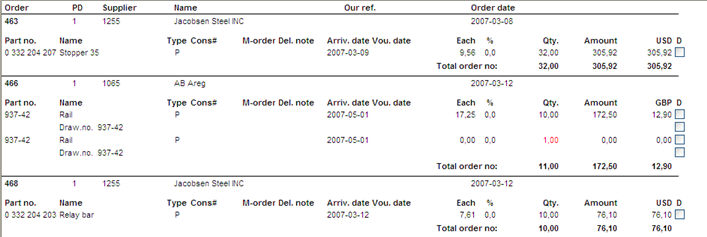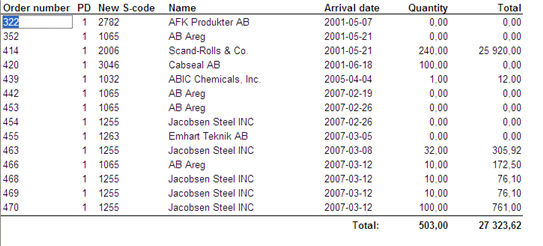Below you will find a few samples of the different list types that can be selected under the Create tab.
At the top of the Standard list you can see the following information about each order: Order number, Partial delivery (PD), Supplier code, Supplier name, Our reference and Order date. Below this you will find the part rows included in the order, with information such as; Part number, Name, Type (P = regular purchase order, S = Subcontracting purchase order), the invoice's Consecutive number, Manufacturing order number (if a link exists), Delivery note number, Arrival date, Voucher date, price Each (or standard price), Discount, Quantity, Amount, a check box (D) used to Delete the invoice basis, Account, and Approved by/when. In the C column you will find a button called C that is used to read and add comments to the invoice. If a comment exists, the symbol # is shown before the C. Beneath the order rows, you will see the order's total amount. At the very bottom of the list, you will see a total amount for all the arrived orders.
Please note that the Consecutive number will only appear for orders that have been linked to an invoice and therefore already been invoiced. You can only "Delete invoice basis" for orders that have not been linked nor invoiced. The deleted invoice bases can be viewed by checking the Only deleted option under the Create tab. When deleting invoice bases, you can see when and by whom the deletion was made.
The parts awaiting Receiving inspection will appear in red font. This list can be valued at purchase price or standard price, with or without SO.

Sample of a Standard list, showing Only arrived, not linked to invoice.

Sample of a Standard list with the selection Linked.
In the Show foreign currency list, the order's foreign currencies will be shown. A total at the bottom of the list shows the total order value for all currencies.

Sample of a Show foreign currency list.
The Only total list only shows the total order value for each supplier and order. You can also see the list as a total per Supplier or per Arrival date. This list can be valued at purchase price or standard price, with or without SO. The columns shown in the list are: Your order number, Our reference, Your reference, Goods label 1 & 2, Quantity (parts), Order rows, and Project number. The columns to the right of the Total column will not be included in the printouts.

Sample of the Only total list, classified by Order number, left portion.

Sample of the Only total list, classified by Order number, right portion (will not be included in printouts).
In the Only total list classified by Supplier code, you will see the columns Supplier code, Supplier name, Quantity, Total, Orders, Order rows, and Quantity (parts).

Sample of the Only total list, classified by Supplier code. The columns Orders, Order rows, and Quantity (parts) will not be included in printouts.
The Coding list is used to see/adjust the coding of the order rows. If coding was performed per cost center, cost unit or project, this will also appear.

Sample of a Coding list.
In the example below you can see the column P. It becomes visible when you activate the setting Manage purchase/manufacturing on project for parts. In the P column you will then see a star/asterisk if the part is purchased on project.

Example of the Coding list type in a system where you have activated the setting Manage purchase/manufacturing on project for parts.
If you use the supplement Warehouse Management, you can check list type Warehouse to see the following info per purchase order number: Partial delivery (PD), Warehouse, Supplier code, Supplier name, Quantity and Total value per order.

Sample of a Warehouse list.
In the Change supplier list you will find information about; Order number, Partial delivery (PD), New supplier code, Name, Arrival date (from the first pos. on the order), Arrived quantity and Total.
In the New S-code column, you can update the supplier code. The supplier on the invoice basis will then be changed.

Sample of a Change supplier list.